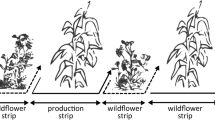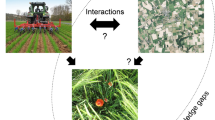Abstract
Shifting cultivation is important to many of the inhabitants of tropical forest regions. Much scientific research has been conducted on this form of agriculture in the humid tropics, but the drier portions of the tropics remain less studied. The shifting cultivation system practiced in the tropical deciduous forests of western Guerrero, Mexico, provides insight into such production systems, especially with regard to crop diversity and fallow characteristics. This system is characterized by low crop diversity, based primarily on maize (Zea mays)cultivation, and a general lack of fallow management. The farmers also utilize several strategies not common to many other regions, including highly seasonal labor allocation patterns, varying fallow cycle lengths, and the occasional application of chemical inputs.
Similar content being viewed by others
References
Alcorn, J. B. (1981). Huastec noncrop management: Implications for prehistoric rain forest management.Human Ecology 9(4): 395–417.
Altieri, M. A. (1987).Agroecology: The Scientific Basis of Alternative Agriculture. Westview Press, Boulder.
Barrau, J. (1959). The “Bush fallowing” system of cultivation in the continental islands of Melanesia.Proceedings, Ninth Pacific Science Congress, Bangkok 7:53–55.
Beckerman, S. (1983). Bari swidden gardens: Crop segregation patterns.Human Ecology 11(1): 85–101.
Beets, W. C. (1982).Multiple Cropping and Tropical Farming Systems. Westview Press, Boulder.
Bejar, A. Shifting Cultivator and Cattle Kaiser in Las Mesillas, Guerrero. Personal communication, 1990, 1991, 1992, and 1993.
Borthakur, D. N., Awasthi, R. P., and Ghosh, S. P. (1980). Alternative systems of farming for increasing productivity in Jhum Lands. In Ray, B. D. (ed.),Shifting Cultivation in North East India. B. T. Hostel, Shillong, India, pp. 85–101.
Brown, J. G., and Ringlien, W. (1987). Post-harvest considerations for diversification. In Davis, T. J., and Schirmer, A. (eds.),Sustainability Issues in Agricultural Development: Proceedings of the Seventh Agriculture Sector Symposium. The World Bank, Washington, D.C., pp. 353–358.
Chacón, J. C., and Gliessman, S. R. (1982). Use of the “non-weed” concept in traditional tropical agroecosystems of south-eastern Mexico.Agro-Ecosystems 8: 1–11.
Clarke, W. C. (1976). Maintenance of agriculture and human habitats within the tropical forest ecosystem.Human Ecology 4(3): 247–259.
Cox, G. W. (1984). The linkage of inputs to outputs in agroecosystems. In Lowrance, R., Stinner, B. R., and House, G. J. (eds.),Agricultural Ecosystems: Unifying Concepts. John Wiley, New York, pp. 187–207.
de Schlippe, P. (1956).Shifting Cultivation in Africa: The Zande System of Agriculture. Routledge and Kegan Paul, London.
Denevan, W. M., and Padoch, C. (1987). Introduction: The Bora agroforestry project. In Denevan, W. M., and Padoch, C. (eds.),Swidden-Fallow Agroforestry in the Peruvian Amazon, Advances in Economic Botany (Vol. 5). The New York Botanical Garden, Bronx, pp. 1–7.
Denevan, W. M., and Treacy, J. M. (1987). Young managed fallows at Brillo Neuvo. In Denevan, W. M., and Padoch, C. (eds.),Swidden-Fallow Agroforestry in the Peruvian Amazon. Advances in Economic Botany (Vol. 5). The New York Botanical Garden, Bronx, pp. 8–46.
Dirección General de Estadística (DGE) (1963).VIII Censo General de Población, 1960, Estado de Guerrero. DGE, México, D.F.
Federer, W. (1993).Statistical Design and Analysis for Intercropping Experiments, Volume I: Two Crops. Springer-Verlag, New York.
Flores Radilla, A. Jefatura de Promoturia, Secretaría de Agricultura y Recursos Hidraulicos (SARH), Zihuatanejo, Guerrero. Personal communication, 1991.
Food and Agriculture Organization of the United Nations (FAO-UN) (1951).Agriculture in Latin America: Current Development and Prospects. FAO, Washington, D.C.
Gallardo, C. G. (1958).Zihuatanejo y la Región. Editorial del Magisterio, México. D. F.
Geertz, C. (1963).Agricultural Involution. University of California Press, Berkeley.
Godoy, R., and Bennett, C. P. A. (1991). The economics of monocropping by smallholders: The case of coconuts in Indonesia.Human Ecology 19(1): 83–98.
Grossman, L. S. (1984).Peasants, Subsistence Ecology, and Development in the Highlands of Papua New Guinea. Princeton University Press, Princeton.
Grossman, L. S. (1992). Pesticides, caution, and experimentation in St. Vincent, Eastern Caribbean.Human Ecology 20(3): 315–336.
Grossman, L. S. (1993). The political ecology of banana exports and local food production in St. Vincent, Eastern Caribbean.Annals of the Association of American Geographers 83(2): 347–367.
Gutiérrez, D., and Obregón Téllez, J. (1988). Tlacolol: Una Siembra de Siglos. In Rodríguez Lazcano, C. (ed.),La Tecnología en Las Sociedades Tradicionales. García Valadés Editores, S. A. de C. V., México, D.F., pp. 51–66.
Haney, E. B. (1968).The Nature of Shifting Cultivation in Latin America. The Land Tenure Center, University of Wisconsin, Madison.
Hart, R. D. (1984). Agroecosystem determinants. In Lowrance, R., Stinner, B. R., and House, G. J. (eds.),Agricultural Ecosystems: Unifying Concepts. John Wiley, New York, pp. 105–119.
Hendricks Pérez, P. R. (1945).Por Tierras Ignotas: Viajes y Observaciones en la Region del Río de las Balsas, Tomo I. Editorial Cultura, México, D.F.
Hendricks Péerez, P. R. (1946).Por Tierras Ignotas: Viajes y Observaciones en la Region del Río de las Balsas, Tomo II. Editorial Cultura, México, D.F.
Instituto Nacional de Estadística Geografía e Informática (INEGI) (1985).Carta de Efectos Climaticos Regionales, Mayo–Octubre, 1∶250,000, Zihuatanejo. INEGI, México, D.F.
Instituto Nacional de Estadística Geografía e Informática (INEGI) (1990a).VI Censo Agrícola-Ganadero y Ejidal, 1981. INEGI, México, D.F.
Instituto Nacional de Estadística Geografía e Informática (INEGI) (1990b).XI Censo General de Población y Vivienda: Cifras Preliminarias. INEGI, México, D.F.
Jackson, W. (1984). Toward a unifying concept for an ecological agriculture. In Lowrance, R., Stinner, B. R., and House, G. J. (eds.),Agricultural Ecosystems: Unifying Concepts. John Wiley, New York, pp. 209–221.
Janzen, D. H. (1986).Guanacaste National Park Tropical Ecological and Cultural Restoration. Editorial Universidad Estatal a Distancia, San José, Costa Rica.
Johnson, A. W. (1971).Sharecroppers of the Sertāo: Economics and Dependence on a Brazilian Plantation. Stanford University Press, Stanford, California.
Joya, E. First Lieutenant of the Mexican Infantry, stationed at Petatlán, Guerrero. Personal communication, 1990.
Kpakote, K. G., and Adjetey-Bahun, A. K. (1985). Ecological problems inherent in the practice of shifting cultivation in Africa. In Bunting, A. H., and Bunting, E. (eds.),The Future of Shifting Cultivation and the Task of Universities. Food and Agriculture Organization of the United Nations, Rome, pp. 50–54.
Lal, R. (1987).Tropical Ecology and Physical Edaphology. John Wiley & Sons, Chichester.
Lambert, D. P. (1992). Changes in a Tropical Dry Forest Shifting Cultivation System, Guerrero, Mexico. Ph.D. dissertation, Department of Geography, University of Texas at Austin.
Lambert, D. P. (1994). Regional core-periphery imbalance: The case of Guerrero, Mexico, since 1821.Yearbook, Conference of Latin Americanist Geographers 20: 59–71.
Lambert, D. P. (in review). New commercial strategies of shifting cultivators in southwestern Mexico.Annals of the Association of American Geographers.
Liebman, M. (1987). Polyculture cropping systems. In Little, P. D., and Horowitz, M. H. (eds.),Lands at Risk in the Third World: Local Level perspective. Westview Press, Boulder, Colorado.
Manner, H. (1981). Ecological succession in new and old swiddens of Montane Papua New Guinea.Human Ecology 9(3): 359–378.
Manshard, W. (1974).Tropical Agriculture: A Geographical Introduction and Appraisal. Longmans, London.
Marroquín Arciga, C. Shifting Cultivator and FormerEjido President in theEjido of La Laja, Guerrero. Personal communication, 1990, 1991, 1992, and 1993.
Marroquín, B. Director, Asocación de Ganadería Local, Zihuatanejo, Guerrero. Personal communication, 1991.
Martin, J. H., Leonard, W. H., and Stamp, D. L. (1976).Principles of Field Crop Production. Macmillan Publishing Co., New York.
Mead, R., and Willey, R. W. (1980). The concept of a “land equivalent ratio” and advantages in yields from intercropping.Experimental Agriculture 16(3): 217–228.
Mishra, B. K., and Ramakrishnan, P. S. (1983a). Slash and burn agriculture at higher elevations in north-eastern India: I. Sediment, water and nutrient losses.Agriculture, Ecosystems and Environment 9: 69–82.
Mishra, B. K., and Ramakrishnan, P. S. (1983b). Slash and burn agriculture at higher elevations in north-eastern India: II. Soil fertility changes.Agriculture, Ecosystems and Environment 9: 83–96.
Mitchell, R. (1984). The ecological basis for comparative primary production. In Lowrance, R., Stinner, B. R., and House, G. J. (eds.),Agricultural Ecosystems: Unifying Concepts. John Wiley, New York, pp. 13–53.
Monroy Hernández, F. J. (1990). Semblanza del proceso productivo del maíz en la Sierra Norte de Guerrero.Monitor Rural: Información y Analisis del Campo Guerrerense 2(1): 13–16.
Murray, D. L., and Hoppin, P. (1990). Pesticides and Nontraditional Agriculture: A Coming Crisis for U.S. Development Policy in Latin America? Texas Papers on Latin America, Paper Number 90-04. Institute of Latin American Studies, University of Texas at Austin, Austin.
Okigbo, B. N. (1985a). Problems and prospects of shifting cultivation. In Bunting, A. H., and Bunting, E. (eds.),The Future of Shifting Cultivation and the Task of Universities. Food and Agriculture Organization of the United Nations, Rome, pp. 55–63.
Okigbo, B. N. (1985b). Shifting cultivation in tropical Africa: Definition and description. In Bunting, A. H., and Bunting E. (eds.),The Future of Shifting Cultivation and the Task of Universities. Food and Agriculture Organization of the United Nations, Rome, pp. 18–36.
Parra Mijangos, J. L., and Monroy Hernández, F. J. (1990). La producción de maíz en Guerrero.Monitor Rural: Informacion y Analisis del Campo Guerrerense 2(1): 3–10.
Ramakrishnan, P. S., and Toky, O. P. (1981). Soil nutrient status of hill agroecosystems and recovery pattern after slash and burn agriculture (Jhum) in north-eastern India.Plant and Soil 60: 41–64.
Ramakrishnan, P. S., and Toky, O. P. (1992).Shifting Agriculture and Sustainable Development: An Interdisciplinary Study from North-Eastern India. Man and the Biosphere Series (Vol. 10). United Nations Educational, Scientific and Cultural Organization, Paris.
Rappaport, R. A. (1971). The flow of energy in an agricultural society.Scientific American 22(3): 116–132.
Richards, A. I. (1939).Land, Labour and Diet in Northern Rhodesia: An Economic Study of the Bemba Tribe. Oxford University Press, London.
Ruthenberg, H. (1969). The economics of introducing fertilizer. InTransition from Extensive to Intensive Agriculture with Fertilizers. International Potash Institute, Berne, Switzerland, pp. 175–184.
Rzedowski, J. (1981).Vegetación de México. Editorial Limusa, S.A., México, D.F.
Saha, N. I. (1980). Levels of production and income under shifting cultivation. In Ray, B. D. (ed.),Shifting Cultivation in North East India. B. T. Hostel, Shillong, India, pp. 19–27.
Seavoy, R. E. (1973). The shading cycle in shifting cultivation.Annals of the Association of American Geographers 63: 522–528.
Secretaría de Programación y Presupuesto (SPP) (1981).Atlas Nacional de Medio Fisico, 1981. SPP, México, D.F.
Sharma, T. C. (1980). The pre-historic background of shifting cultivation. In Ray, B. D. (ed.),Shifting Cultivation in North East India. B. T. Hostel, Shillong, India, pp. 1–5.
Stott, P. (1988). The forest as phoenix: Towards a biogeography of fire in mainland south east Asia.The Geographical Journal 154(3): 337–350.
Swamy, P. S., and Ramakrishnan, P. S. (1987). Contribution ofMikaniamicrantha during secondary succession following slash and burn agriculture (Jhum) in north-eastern India: I. Biomass, litterfall and productivity.Forest Ecology and Management 22: 229–237.
Toky, O. P., and Ramakrishnan, P. S. (1981). Cropping and yields in agricultural systems of the northeastern hill region of India.Agro-Ecosystems 7: 11–25.
Treacy, J. (1982). Bora Indian agroforestry: An alternative to deforestation.Cultural Survival Quarterly 6(2): 15–16.
Trenblath, B. R. (1974). Biomass productivity of mixtures.Advances in Agronomy 26: 177–210.
Wellhausen, E. J., Roberts, L. M., Hernández, X. E., and Mangelsdorf, P. C. (1952).Races of Maize in Mexico: Their Origin, Characteristics and Distribution. The Bussey Institute of Harvard University, Cambridge, Massachusetts.
Whittaker, R. H. (1972). Evolution and measurement of species diversity.Taxon 21(2/3): 213–251.
Wilk, R. R. (1991).Household Ecology: Economic Change and Domestic Life Among the Kekchi Maya in Belize. University of Arizona Press, Tucson.
Wilken, G. C. (1987).Good Farmers: Traditional Agricultural Resource Management in Mexico and Central America. University of California Press, Los Angeles.
Woods, F. W., and Ostermeier, D. (1985). Agroforestry: A lesson from the Third World.Futurist 19(4): 24–26.
World Resources Institute, International Institute for Environment and Development, and United Nations Environmental Programme. (1988).World Resources 1988–89: An Assessment of the Resource Base that Supports the Global Economy. Basic Books, New York.
World Resources Institute, International Institute for Environment and Development, and United Nations Environmental Programme. (1990).World Resources 1990–91: An Assessment of the Resource Base that Supports the Global Economy. Basic Books, New York.
Author information
Authors and Affiliations
Rights and permissions
About this article
Cite this article
Lambert, D.P. Crop diversity and fallow management in a tropical deciduous forest shifting cultivation system. Hum Ecol 24, 427–453 (1996). https://doi.org/10.1007/BF02168861
Issue Date:
DOI: https://doi.org/10.1007/BF02168861




